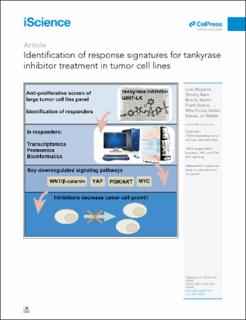| dc.contributor.author | Mygland, Line | |
| dc.contributor.author | Mahmuda, Shoshy | |
| dc.contributor.author | Strand, Martin Frank | |
| dc.contributor.author | Olsen, Petter Angell | |
| dc.contributor.author | Aizenshtadt, Aleksandra | |
| dc.contributor.author | Lund, Kaja | |
| dc.contributor.author | Solberg, Nina | |
| dc.contributor.author | Lycke, Eric Maximilian | |
| dc.contributor.author | Thorvaldsen, Tor Espen | |
| dc.contributor.author | Espada, Sandra | |
| dc.contributor.author | Misaghian, Dorna | |
| dc.contributor.author | Page, Christian Magnus | |
| dc.contributor.author | Agafonov, Oleg | |
| dc.contributor.author | Nygård, Ståle | |
| dc.contributor.author | Chi, Nai-Wen | |
| dc.contributor.author | Lin, Eva | |
| dc.contributor.author | Tan, Jenille | |
| dc.contributor.author | Yu, Yihong | |
| dc.contributor.author | Costa, Mike | |
| dc.contributor.author | Krauss, Stefan | |
| dc.contributor.author | Waaler, Jo | |
| dc.date.accessioned | 2021-12-10T11:58:22Z | |
| dc.date.available | 2021-12-10T11:58:22Z | |
| dc.date.created | 2021-08-06T11:51:09Z | |
| dc.date.issued | 2021 | |
| dc.identifier.citation | iScience. 2021, 24 (7), 1-26. | en_US |
| dc.identifier.issn | 2589-0042 | |
| dc.identifier.uri | https://hdl.handle.net/11250/2833774 | |
| dc.description.abstract | Small-molecule tankyrase 1 and tankyrase 2 (TNKS1/2) inhibitors are effective antitumor agents in selected tumor cell lines and mouse models. Here, we characterized the response signatures and the in-depth mechanisms for the antiproliferative effect of tankyrase inhibition (TNKSi). The TNKS1/2-specific inhibitor G007-LK was used to screen 537 human tumor cell lines and a panel of particularly TNKSi-sensitive tumor cell lines was identified. Transcriptome, proteome, and bioinformatic analyses revealed the overall TNKSi-induced response signatures in the selected panel. TNKSi-mediated inhibition of wingless-type mammary tumor virus integration site/b-catenin, yes-associated protein 1 (YAP), and phosphatidylinositol-4,5-bisphosphate 3-kinase/AKT signaling was validated and correlated with lost expression of the key oncogene MYC and impaired cell growth. Moreover, we show that TNKSi induces accumulation of TNKS1/2-containing b-catenin degradasomes functioning as core complexes interacting with YAP and angiomotin proteins during attenuation of YAP signaling. These findings provide a contextual and mechanistic framework for using TNKSi in anticancer treatment that warrants further comprehensive preclinical and clinical evaluations. | en_US |
| dc.language.iso | eng | en_US |
| dc.rights | Navngivelse 4.0 Internasjonal | * |
| dc.rights.uri | http://creativecommons.org/licenses/by/4.0/deed.no | * |
| dc.title | Identification of response signatures for tankyrase inhibitor treatment in tumor cell lines | en_US |
| dc.type | Peer reviewed | en_US |
| dc.type | Journal article | en_US |
| dc.description.version | publishedVersion | en_US |
| dc.source.pagenumber | 1-26 | en_US |
| dc.source.volume | 24 | en_US |
| dc.source.journal | iScience | en_US |
| dc.source.issue | 7 | en_US |
| dc.identifier.doi | 10.1016/j.isci.2021.102807 | |
| dc.identifier.cristin | 1924361 | |
| cristin.ispublished | true | |
| cristin.fulltext | original | |
| cristin.qualitycode | 1 | |

